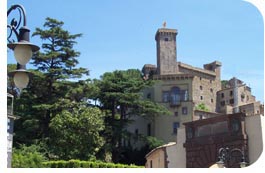
This lake is situated in the main caldera of the volcanic group Vulsinio, it is an elliptic shape.
With a surface of 114.5 square km., max depth 151 m. and a boundary of 43 km.; from it emerge
two isles:Bisentina and Martana, probably residual volcanic products.
It is mainly fed by raining water and there are numerous tributaries with just one effluent:
Marta river that has its source from the port of the homonymous village and it flows into the
Tirreno sea. On the fertile shores, in addition to oak and chestnut woods, alternates farming
of vines, olives and vegetables. Among the various tourist attractions, the below mentioned
are those with a cultural and archaeological purpose; as a matter of fact on the lake's shore
followed one another the Villanoviana, Etruscan and Roman civilization, while the medieval
period left its important mark in the small near villages.

The prehistoric man left firm and unequivocal marks of his
presence, from Neolithic till the Iron Age passing through
the Bronze one. Important "Villanoviani", then Etruscan
centers were Visentium (Bisenzio) 2 km. West from
Capodimonte and Vezna, that will be the roman Volsinii,
then Bolsena. After the Etruscan, the Roman, the Barbarian
invasions, the Church and the aristocracy, the Farnese
family marked the recent history of this area.
The fishes in the lake are still numerous in spite of the
professional fishing and the wrong scattering of infesting fry; the eels, already known by the
Roman, are quoted by Dante in the Divine

Comedy. Further than these fishes, in the lake
nowadays are: Coregonus, luces, perches, trout
perches, tenches, carps, scardola (here wrongly
called lasca). And at the end the little latterino,
always quarry of pillager fishes or aquatic birds.
The presence of aquatic birds, especially
migratory, is high because of the feed's abundance and the protection given to them; it's fantastic
for the people who love bird-watching finding a paradise near to home but for the fishermen is a
trouble.

